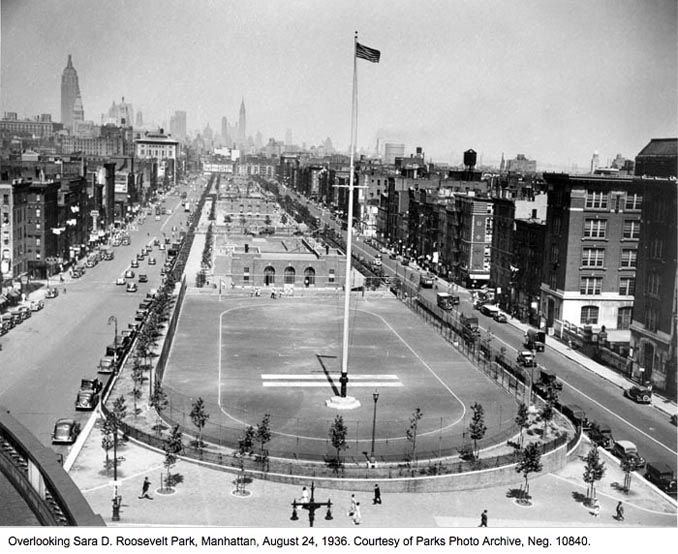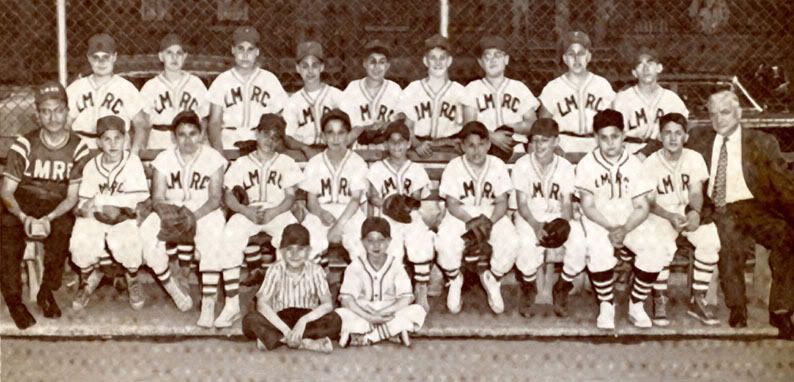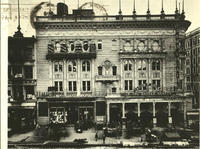 Quite a find at the NYPL! Either there is new material there, or there are nooks and crannies previously undiscovered. No date, however. The Grand was demolished in 1929 when the area was cleared for Roosevelt Park. This slide show is compromised of photos taken by Percy Loomis Speer. I would guess it was part of an effort to document the large scale clearing of buildings that was required to build the park. FDR was the Governor of the state at the time and my understanding is the Eleanor, who had worked for a time at University Settlement, was instrumental in making the case for urban renewal. Maybe he resisted and part of his concession was that he had to name it after his domineering mother.
Quite a find at the NYPL! Either there is new material there, or there are nooks and crannies previously undiscovered. No date, however. The Grand was demolished in 1929 when the area was cleared for Roosevelt Park. This slide show is compromised of photos taken by Percy Loomis Speer. I would guess it was part of an effort to document the large scale clearing of buildings that was required to build the park. FDR was the Governor of the state at the time and my understanding is the Eleanor, who had worked for a time at University Settlement, was instrumental in making the case for urban renewal. Maybe he resisted and part of his concession was that he had to name it after his domineering mother.
Showing posts with label sara delano roosevelt park. Show all posts
Showing posts with label sara delano roosevelt park. Show all posts
Saturday, October 29, 2011
Playing At The Grand
originally from the early days of pseudo-intellectualism
 Quite a find at the NYPL! Either there is new material there, or there are nooks and crannies previously undiscovered. No date, however. The Grand was demolished in 1929 when the area was cleared for Roosevelt Park. This slide show is compromised of photos taken by Percy Loomis Speer. I would guess it was part of an effort to document the large scale clearing of buildings that was required to build the park. FDR was the Governor of the state at the time and my understanding is the Eleanor, who had worked for a time at University Settlement, was instrumental in making the case for urban renewal. Maybe he resisted and part of his concession was that he had to name it after his domineering mother.
Quite a find at the NYPL! Either there is new material there, or there are nooks and crannies previously undiscovered. No date, however. The Grand was demolished in 1929 when the area was cleared for Roosevelt Park. This slide show is compromised of photos taken by Percy Loomis Speer. I would guess it was part of an effort to document the large scale clearing of buildings that was required to build the park. FDR was the Governor of the state at the time and my understanding is the Eleanor, who had worked for a time at University Settlement, was instrumental in making the case for urban renewal. Maybe he resisted and part of his concession was that he had to name it after his domineering mother.
 Quite a find at the NYPL! Either there is new material there, or there are nooks and crannies previously undiscovered. No date, however. The Grand was demolished in 1929 when the area was cleared for Roosevelt Park. This slide show is compromised of photos taken by Percy Loomis Speer. I would guess it was part of an effort to document the large scale clearing of buildings that was required to build the park. FDR was the Governor of the state at the time and my understanding is the Eleanor, who had worked for a time at University Settlement, was instrumental in making the case for urban renewal. Maybe he resisted and part of his concession was that he had to name it after his domineering mother.
Quite a find at the NYPL! Either there is new material there, or there are nooks and crannies previously undiscovered. No date, however. The Grand was demolished in 1929 when the area was cleared for Roosevelt Park. This slide show is compromised of photos taken by Percy Loomis Speer. I would guess it was part of an effort to document the large scale clearing of buildings that was required to build the park. FDR was the Governor of the state at the time and my understanding is the Eleanor, who had worked for a time at University Settlement, was instrumental in making the case for urban renewal. Maybe he resisted and part of his concession was that he had to name it after his domineering mother.
Friday, October 28, 2011
1905 Map Of Grand, Forsyth, Hester, Chrystie Area
originally from the early days of pseudo-intellectualism
 Another Sanborn Insurance gem. A shout out to my nephew Jamie, whose U of Buffalo attendance provided digital library access. Here's a math tech integration activity. "If there were x number of synagogues on these y square blocks, how many synagogues would there be on z square blocks?' The spot where I placed an image of the real PS 7 was an empty lot. The front of PS 7 faced Chrystie Street. The area is now part of Sara Delano Roosevelt Park. In the 1896 Tribune, the school was described as the dirtiest school in the city. Behind the Grand Theater there are "Bowling Alleys and a Turkish Bathouse. I'll try to see who was playing at the Grand Theater. The hook and ladder company on Canal Street is still a fire house 100 years later. The Boarding Stable on Allen Street logically became a parking garage. BTW, SD stands for steel door.
Another Sanborn Insurance gem. A shout out to my nephew Jamie, whose U of Buffalo attendance provided digital library access. Here's a math tech integration activity. "If there were x number of synagogues on these y square blocks, how many synagogues would there be on z square blocks?' The spot where I placed an image of the real PS 7 was an empty lot. The front of PS 7 faced Chrystie Street. The area is now part of Sara Delano Roosevelt Park. In the 1896 Tribune, the school was described as the dirtiest school in the city. Behind the Grand Theater there are "Bowling Alleys and a Turkish Bathouse. I'll try to see who was playing at the Grand Theater. The hook and ladder company on Canal Street is still a fire house 100 years later. The Boarding Stable on Allen Street logically became a parking garage. BTW, SD stands for steel door.
 Another Sanborn Insurance gem. A shout out to my nephew Jamie, whose U of Buffalo attendance provided digital library access. Here's a math tech integration activity. "If there were x number of synagogues on these y square blocks, how many synagogues would there be on z square blocks?' The spot where I placed an image of the real PS 7 was an empty lot. The front of PS 7 faced Chrystie Street. The area is now part of Sara Delano Roosevelt Park. In the 1896 Tribune, the school was described as the dirtiest school in the city. Behind the Grand Theater there are "Bowling Alleys and a Turkish Bathouse. I'll try to see who was playing at the Grand Theater. The hook and ladder company on Canal Street is still a fire house 100 years later. The Boarding Stable on Allen Street logically became a parking garage. BTW, SD stands for steel door.
Another Sanborn Insurance gem. A shout out to my nephew Jamie, whose U of Buffalo attendance provided digital library access. Here's a math tech integration activity. "If there were x number of synagogues on these y square blocks, how many synagogues would there be on z square blocks?' The spot where I placed an image of the real PS 7 was an empty lot. The front of PS 7 faced Chrystie Street. The area is now part of Sara Delano Roosevelt Park. In the 1896 Tribune, the school was described as the dirtiest school in the city. Behind the Grand Theater there are "Bowling Alleys and a Turkish Bathouse. I'll try to see who was playing at the Grand Theater. The hook and ladder company on Canal Street is still a fire house 100 years later. The Boarding Stable on Allen Street logically became a parking garage. BTW, SD stands for steel door.
Friday, September 18, 2009
Sara Delano Roosevelt Park: Now And Then
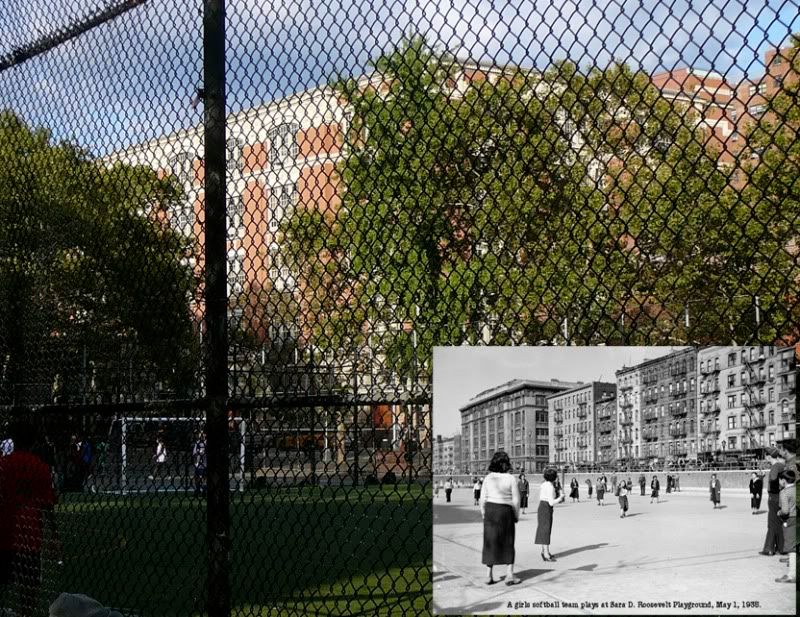 I tried my best to match up the scene from the last post. Soccer and basketball now reign in the park, not softball.
I tried my best to match up the scene from the last post. Soccer and basketball now reign in the park, not softball.
Labels:
parks,
sara delano roosevelt park,
then and now,
Ward 10
Playing Softball In Sara Delano Roosevelt Park 1935
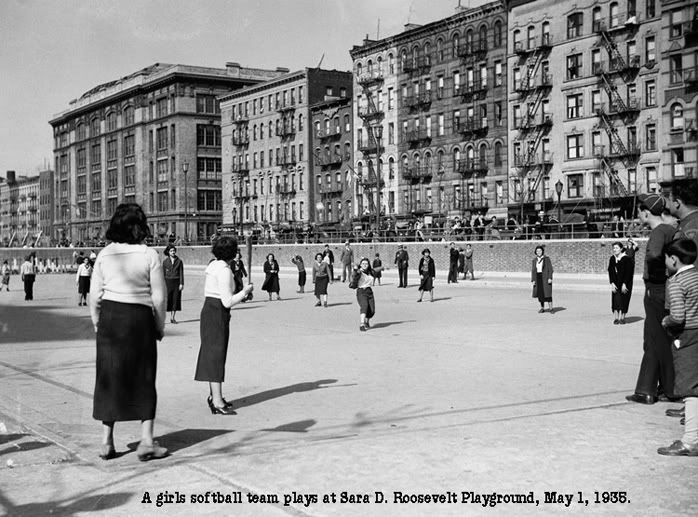
The view is looking NE towards Forsyth Street. PS 91 is seen in the distance on the corner of Stanton Street. The picture comes from the nyc parks collection
Labels:
baseball,
sara delano roosevelt park,
schools,
Ward 10
Wednesday, September 9, 2009
600 Arrested In Raid On Dance Hall: Feb. 16, 1921

Somehow I forgot to post the above article with below a close up version of the picture from a previous post Things must have been smoking at that "smoker." The picture is circa 1930 when buildings were being demolished for Sara Delano Roosevelt Park. The Odd Fellows Hall is the six story building in the middle with the awning.
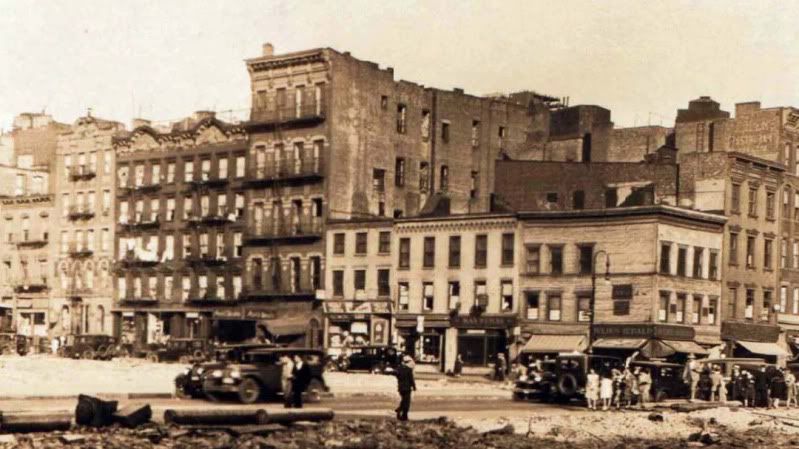
The Libby Hotel
Libby Hotel
Images from a fascinating article about the hotel's rise and fall in the 1920's and how its fate was tied to Judge Crater. It was located on Delancey and Chrystie StreetsFrom the Pakn Treger Archive
Images from a fascinating article about the hotel's rise and fall in the 1920's and how its fate was tied to Judge Crater. It was located on Delancey and Chrystie StreetsFrom the Pakn Treger Archive
Labels:
judge crater,
libby hotel,
sara delano roosevelt park,
Ward 10
Plans For The Construction On Forsyth Street
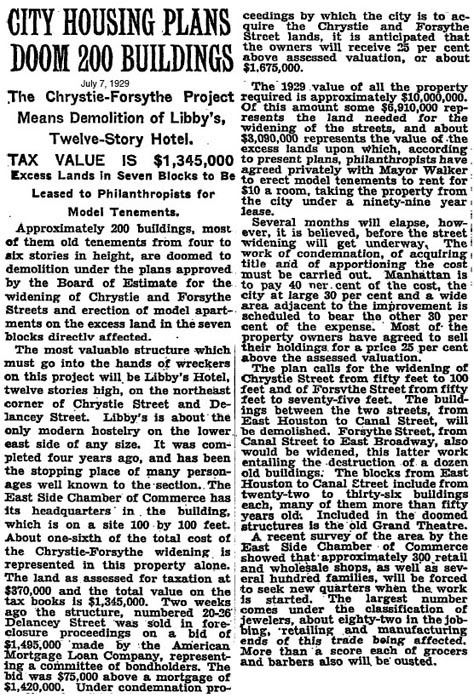
Originally new construction was supposed to take place, but then the depression changed plans. As a result Sara Delano Park was built. The sale of the Libby Hotel played a part in the disappearance of Judge Crater. An excerpt from an article in the nypress from June 25, 2002
The Missingest Man in New York, By William Bryk
Every Aug. 6 for more than three decades, an attractive older woman entered a Greenwich Village bar, a place that had been a restaurant back in the Jazz Age. She sat alone in a booth and ordered two cocktails. She raised one, murmured, "Good luck, Joe, wherever you are." She drank it slowly, rose and walked out, leaving the other drink untouched.
Thus Stella Crater mourned her vanished husband, Justice Joseph Force Crater, who became famous on Aug. 6, 1930, when he, as the Daily News later said, "disappeared efficiently, completely, and forever."
Born to Irish immigrants in Easton, PA, in 1889, Joe Crater worked his way through Lafayette College and Columbia Law School. He opened his office at 120 Broadway (the Equitable Bldg., a huge white marble pile that was once the largest office building in the world) and joined the Cayuga Democratic Club, the power base of Tammany district leader Martin Healy, where Crater spent thousands of hours organizing election workers and representing the club in election law cases. He also married Stella Wheeler, whom he had represented in her 1912 divorce.
State Supreme Court Justice Robert F. Wagner Sr., who became a United States senator in 1926, appointed Crater his secretary in 1920. Joe was also an adjunct professor at Fordham and New York University law schools. But most of his income came through his law practice, which was enriched by his political connections. At first, he received the usual minor appointments from the courts: receiverships, refereeships, guardianships. Over time, Crater’s pieces of pie were cut large. In February 1929, he was appointed receiver in foreclosure of the Libby Hotel. Four months later, the hotel was auctioned for $75,000 to the American Mortgage Loan Co. Two months after that, the City of New York condemned the hotel, paying American Mortgage Loan $2,850,000–a profit of $2,775,000 on its two months’ investment of $75,000. Some cynics suggested American Mortgage Loan’s managers knew about the city’s plans before buying the building.
Crater could afford a new apartment: a two-bedroom cooperative at 40 5th Ave. He became president of the Cayuga Club and Martin Healy’s right-hand man. And on April 8, 1930, Gov. Franklin D. Roosevelt appointed him to a vacancy on the state Supreme Court (among New York state courts, the Supreme Court is actually the lowest court, comparable to superior courts in other states). Politics had everything to do with it. So did ability: even the respectables at the Association of the Bar of the City of New York supported Joe’s appointment.
He was 41 years old–young for a Supreme Court justice in New York. Crater was a well-tailored 185-pound 6-footer, with fleshy features and slicked-down iron-gray hair that made him seem older than he was. He was a fine pianist, a good dancer and liked theater.
Labels:
judge crater,
libby hotel,
sara delano roosevelt park,
Ward 10
Subscribe to:
Posts (Atom)

